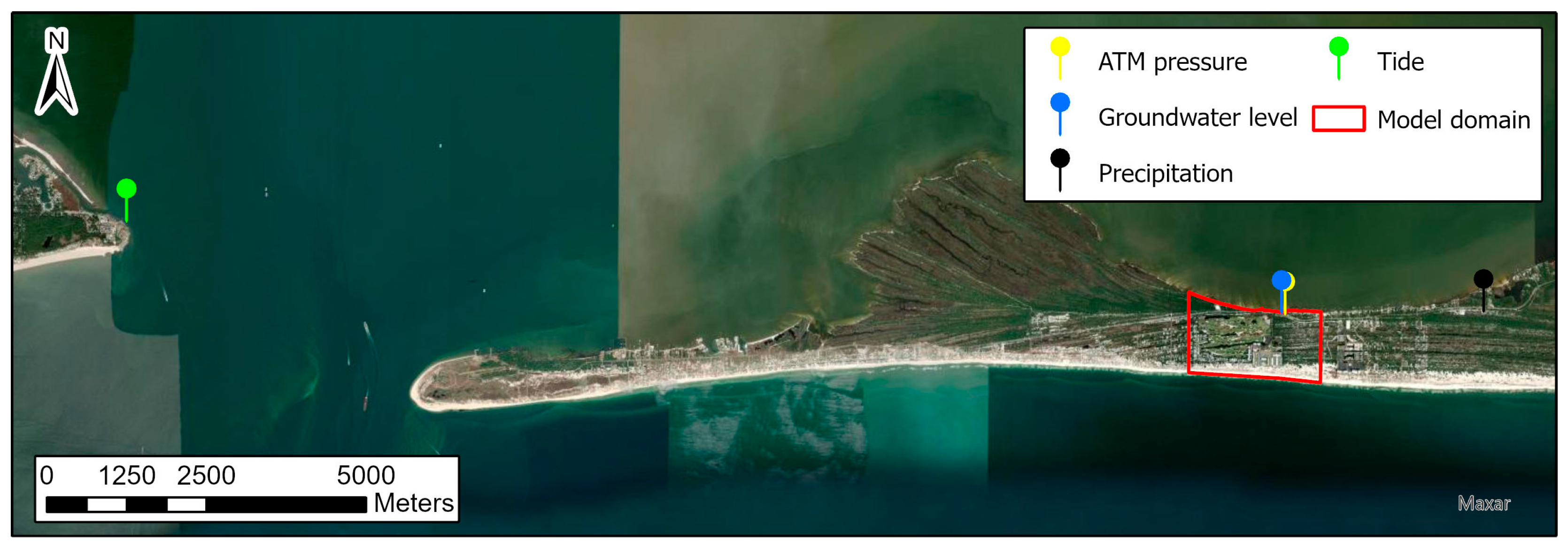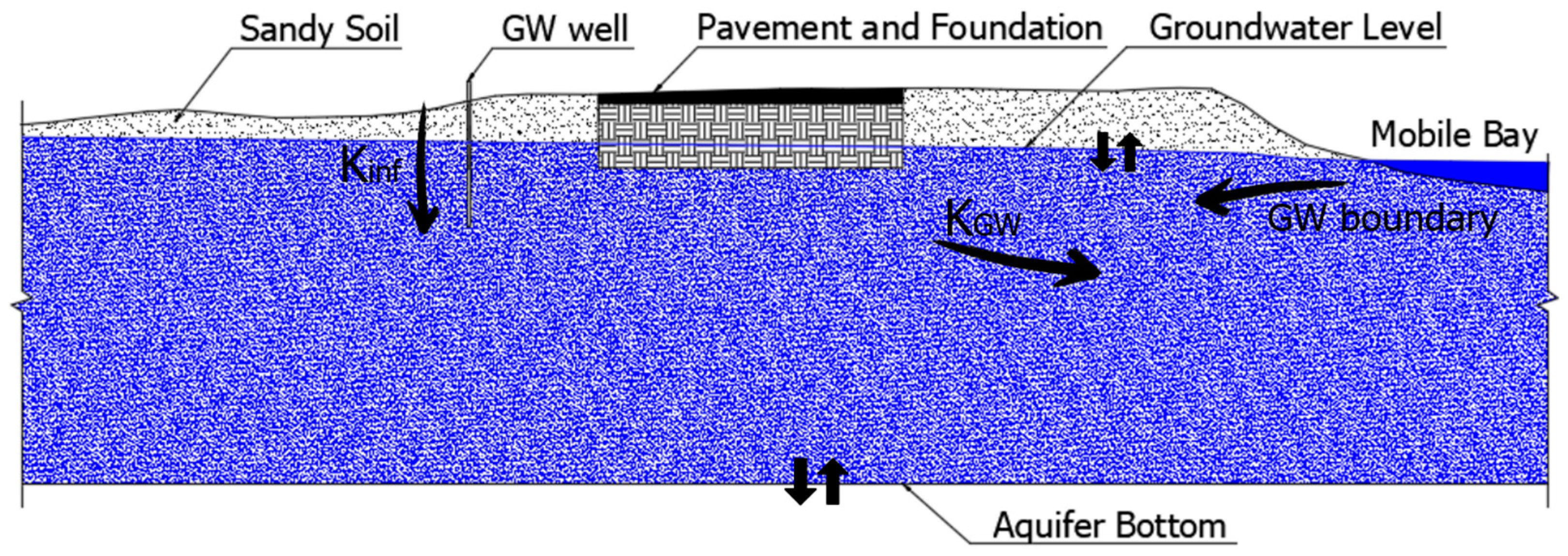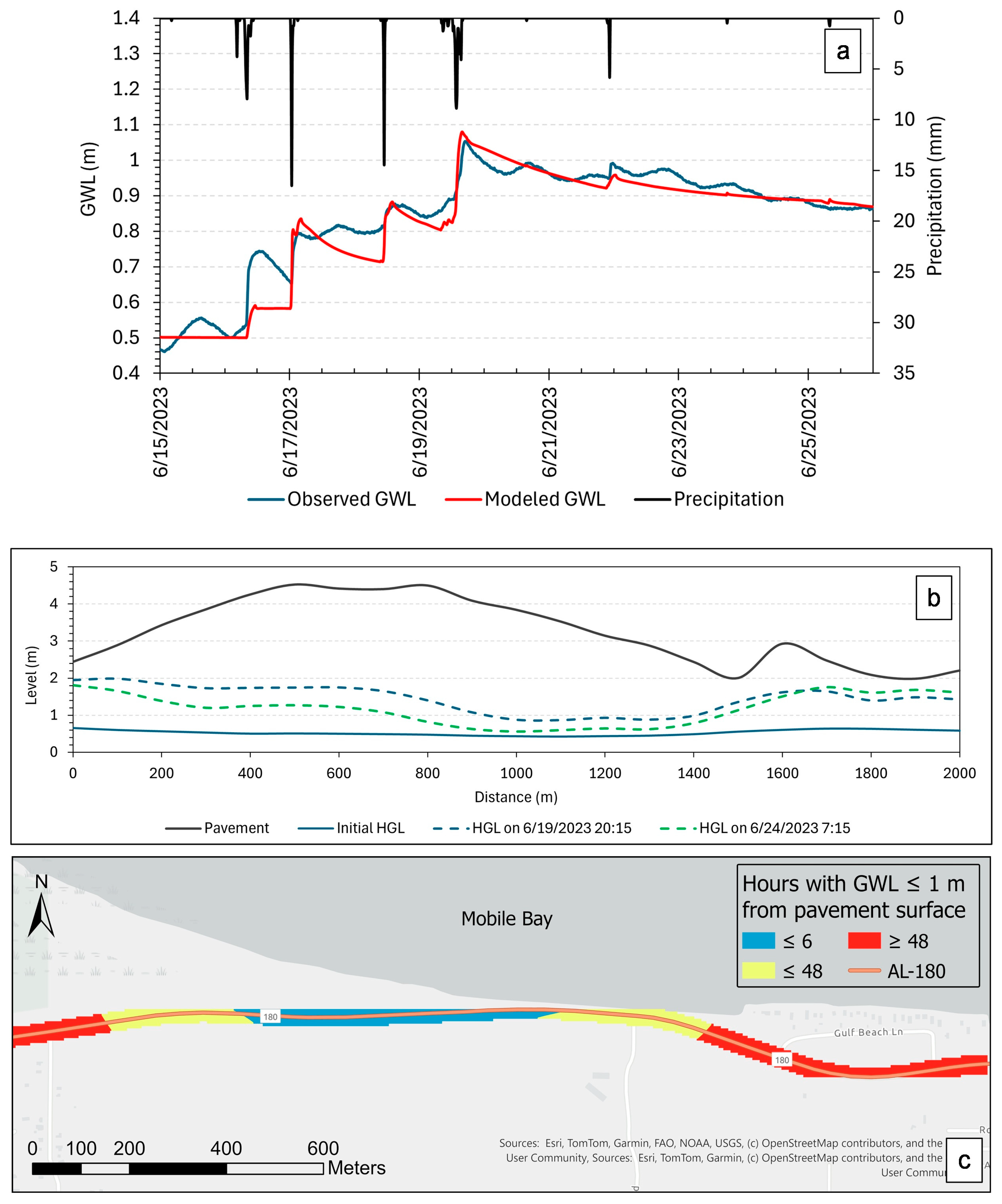Evaluating Distributed Hydrologic Modeling to Assess Coastal Highway Vulnerability to High Water Tables
Abstract
1. Introduction
2. Materials and Methods
2.1. Study Area
2.2. Data
2.3. Land Cover Classification Using GeOBIA
2.4. Modeling
- The Green–Ampt infiltration method was used, adjusting hydraulic conductivity to reflect local land cover. Paved surfaces were assigned lower infiltration rates to replicate urban runoff behavior. Infiltration was modeled using the Green–Ampt equation with redistribution, a method recognized as a close approximation to the numerical solution of Richards’ Equation [39]. Table 1 illustrates the remaining infiltration parameters used in this study. Hydraulic conductivities were reduced following the indices found by [40] for the different land cover classes.
- Surface roughness parameters were assigned based on the resultant land cover classifications shown in Figure 3. The authors converted the land use classification to a 3 m cell resolution raster, to improve software performance. Then, it was uploaded to the project and converted into a land use grid, which allowed Manning’s n values to be set for each land cover classification.
- Groundwater–surface water interactions were also included, accounting for additional parameters such as aquifer depth, initial water table elevations, hydraulic conductivity, and soil porosity.
- Initial water table elevation is spatially variable, with the levels matching Mobile Bay and the Gulf of America to the north and south boundaries, respectively. Higher water table elevations are assumed with increased distance from the coast, reaching 1 m above the current sea level at the start of the simulation. Furthermore, due to the same land use and elevation, GW flows are assumed not to occur through the east and west borders of the subcatchment. As a result, GW discharges occur only through the northern and southern borders of the model.
2.4.1. Model Setup
2.4.2. Boundary Conditions
2.4.3. Model Evaluation
3. Results
3.1. Calibration Results
3.2. Validation Results
3.3. Model Performance
3.4. Extreme Event Modeling
4. Discussion
5. Conclusions
Author Contributions
Funding
Data Availability Statement
Acknowledgments
Conflicts of Interest
References
- Easterling, D.R.; Kunkel, K.E.; Arnold, J.R.; Knutson, T.R.; LeGrande, A.N.; Leung, L.R.; Vose, R.S.; Waliser, D.E.; Wehner, M. Precipitation Change in the United States. In: Climate Science Special Report: Fourth National Climate Assessment. Fourth Natl. Clim. Assess. 2017, I, 207–230. [Google Scholar] [CrossRef]
- Sun, Q.; Zhang, X.; Zwiers, F.; Westra, S.; Alexander, L.V. A Global, Continental, and Regional Analysis of Changes in Extreme Precipitation. J. Clim. 2021, 34, 243–258. [Google Scholar] [CrossRef]
- Sweet, W.V.; Kopp, R.E.; Weaver, C.P.; Obeysekera, J.; Horton, R.M.; Thieler, E.R.; Zervas, C. Global and Regional Sea Level Rise Scenarios for the United States; NOAA Technical Report NOS CO-OPS 083; 2017; pp. 1–56. Available online: https://repository.library.noaa.gov/view/noaa/18399 (accessed on 11 June 2025).
- Knott, J.F.; Daniel, J.S.; Jacobs, J.M.; Kirshen, P. Adaptation Planning to Mitigate Coastal-Road Pavement Damage from Groundwater Rise Caused by Sea-Level Rise. Transp. Res. Rec. 2018, 2672, 11–22. [Google Scholar] [CrossRef]
- Cox, A.H.; Loomis, G.W.; Amador, J.A. Preliminary Evidence That Rising Groundwater Tables Threaten Coastal Septic Systems. J. Sustain. Water Built Environ. 2019, 5, 04019007. [Google Scholar] [CrossRef]
- Peña, F.; Obeysekera, J.; Jane, R.; Nardi, F.; Maran, C.; Cadogan, A.; de Groen, F.; Melesse, A. Investigating Compound Flooding in a Low Elevation Coastal Karst Environment Using Multivariate Statistical and 2D Hydrodynamic Modeling. Weather. Clim. Extrem. 2023, 39, 100534. [Google Scholar] [CrossRef]
- Lee, S.; Yen, H.; Yeo, I.Y.; Moglen, G.E.; Rabenhorst, M.C.; McCarty, G.W. Use of Multiple Modules and Bayesian Model Averaging to Assess Structural Uncertainty of Catchment-Scale Wetland Modeling in a Coastal Plain Landscape. J. Hydrol. 2020, 582, 124544. [Google Scholar] [CrossRef]
- Yuan, L.; Mikelonis, A.M.; Yan, E. Using SWMM for Emergency Response Planning: A Case Study Evaluating Biological Agent Transport under Various Rainfall Scenarios and Urban Surfaces. J. Hazard. Mater. 2023, 458, 131747. [Google Scholar] [CrossRef] [PubMed]
- Palanisamy, B.; Borkar, R.; Sangeetha, K.; Narasimhan, B. Evaluation of Augmented Infiltration Based LIDs for Low Lying Urbanizing Coastal Catchments: A Case Study of Chennai City, India. Urban. Water J. 2024, 21, 638–655. [Google Scholar] [CrossRef]
- Vasconcelos, J.G.; Fang, X.; Geller, V.G.; Nicolaico, G.G.; Reyes, E.M. Resilient Design with Distributed Rainfall-Runoff Modeling; Transportation Research Board: Washington, DC, USA, 2023; ISBN 978-0-309-69861-0. [Google Scholar]
- Ahmari, H.; Hummel, M.; Chao, S.-H.; Md Imran Kabir, S.; Pervaiz, F.; Acharya, B.R.; Dean, M.; Mowla, Q.A.E. Identify and Analyze Inundated Bridge Superstructures in High Velocity Flood Events; United States Department of Transportation: Arlington, VA, USA, 2021.
- Thomas, W.; Newell, D.; Bernzott, E.; Szekeres, D.; Harris, J.; Tabb, C.; Siddiquee, F. Development of Site-Specific Hydrologic and Hydraulic Analyses for Assessing Transportation Infrastructure Vulnerability & Risks to Climate Change; United States Department of Transportation: Harrisburg, PA, USA, 2020.
- Giacomoni, M.H.; Olivera, F.; do Lago, C. Assessing the Impacts of Super Storm Flooding in the Transportation Infrastructure–Case Study: San Antonio, Texas; United States Department of Transportation: Baton Rouge, LA, USA, 2019.
- Vasconcelos, J.G.; Fang, X.; Anderson, J.B.; Tamang, S.; Song, W. Analysis and Potential Solutions to Sediment Deposition in Dean Road Bridge Watershed, Midland City, AL; United States Department of Transportation: Auburn, AL, USA, 2018.
- Schwartz, J.S. Evaluation and Prediction of Bridge Pier and Contraction Scour of Cohesive River Sediments in Tennessee; United States Department of Transportation: Knoxville, TN, USA, 2018.
- Zhang, Q.; Lu, Q.; Kwon, C.; Xu, X.; Schreiber, D. Spatial Sustainability Assessment of Green Stormwater Infrastructure for Surface Transportation Planning, Phase I; University of South Florida, Center for Transportation, Environment, and Community Health, U.S. Department of Transportation: Tampa, FL, USA, 2018. [Google Scholar]
- Herb, W.; Janke, B.; Stefan, H. Study of De-Icing Salt Accumulation and Transport Through a Watershed; Minnesota Department of Transportation, Research Services & Library: Minneapolis, MN, USA, 2017. [Google Scholar]
- Hoogestraat, G. Rainfall-Runoff Modeling for Improved Peak Flow Estimates in the Black Hills Area of South Dakota; United States Department of Transportation: Rapid City, SD, USA, 2017. [Google Scholar]
- Scharffenberg, W. Hydrologic Modeling System HEC-HMS User’s Manual; Hydrologic Engineering Center (HEC), U.S. Army Corps of Engineers: Davis, CA, USA, 2016.
- Rossman, L.A. Storm Water Management Model User’s Manual Version 5.1; United States Environmental Protection Agency (U.S. EPA), National Risk Management Research Laboratory (NRMRL), Office of Research and Development (ORD): Cincinnati, OH, USA, 2015.
- Bragg, M.A.; Poudel, A.; Vasconcelos, J.G. Comparing SWMM and HEC-RAS Hydrological Modeling Performance in Semi-Urbanized Watershed. Water 2025, 17, 1331. [Google Scholar] [CrossRef]
- Kampf, S.K.; Burges, S.J. A Framework for Classifying and Comparing Distributed Hillslope and Catchment Hydrologic Models. Water Resour. Res. 2007, 43, 5370. [Google Scholar] [CrossRef]
- Downer, C.W.; Ogden, F.L. Prediction of Runoff and Soil Moistures at the Watershed Scale: Effects of Model Complexity and Parameter Assignment. Water Resour. Res. 2003, 39, 1439. [Google Scholar] [CrossRef]
- Weston, D.M.; Skahill, B.E.; Downer, C.W.; Graulau-Santiago, J.A.; Pradhan, N.; Byrd, A.R. Gridded Surface Subsurface Hydrologic Analysis Modeling for Analysis of Flood Design Features at the Picayune Strand Restoration Project. In Proceedings of the World Environmental and Water Resources Congress 2015, Austin, TX, USA, 17–21 May 2015; pp. 1500–1511. [Google Scholar] [CrossRef]
- Brendel, C.E.; Dymond, R.L.; Aguilar, M.F. Modeling Storm Sewer Networks and Urban Flooding in Roanoke, Virginia, with SWMM and GSSHA. J. Hydrol. Eng. 2021, 26, 5020044. [Google Scholar] [CrossRef]
- Fry, T.J.; Maxwell, R.M. Using a Distributed Hydrologic Model to Improve the Green Infrastructure Parameterization Used in a Lumped Model. Water 2018, 10, 1756. [Google Scholar] [CrossRef]
- Hamedi, A.; Fuentes, H.R. Comparative Effectiveness and Reliability of NEXRAD Data to Predict Outlet Hydrographs Using the GSSHA and HEC-HMS Hydrologic Models. 2015, pp. 1444–1453. Available online: https://ascelibrary.org/doi/10.1061/9780784479162.142 (accessed on 11 January 2024).
- Sith, R.; Nadaoka, K. Comparison of SWAT and GSSHA for High Time Resolution Prediction of Stream Flow and Sediment Concentration in a Small Agricultural Watershed. Hydrology 2017, 4, 27. [Google Scholar] [CrossRef]
- Moore, M.F.; Vasconcelos, J.G.; Zech, W.C. Modeling Highway Stormwater Runoff and Groundwater Table Variations with SWMM and GSSHA. J. Hydrol. Eng. 2017, 22, 1–15. [Google Scholar] [CrossRef]
- Karamouz, M.; Ahmadvand, F.; Zahmatkesh, Z. Distributed Hydrologic Modeling of Coastal Flood Inundation and Damage: Nonstationary Approach. J. Irrig. Drain. Eng. 2017, 143, 1–14. [Google Scholar] [CrossRef]
- Kimball, S.K.; Terwey, W. South Alabama Mesonet. Available online: http://chiliweb.southalabama.edu/archived_data.php (accessed on 21 September 2024).
- Beck, H.E.; Zimmermann, N.E.; Mcvicar, T.R.; Vergopolan, N.; Berg, A.; Wood, E.F. Data Descriptor: Present and Future Köppen-Geiger Climate Classi Fi Cation Maps at 1 -Km Resolution. Sci. Data 2018, 5, 1–12. [Google Scholar] [CrossRef] [PubMed]
- Soil Survey Staff Web Soil Survey. Available online: http://websoilsurvey.sc.egov.usda.gov/ (accessed on 11 January 2024).
- OCM Partners AIP Digital Orthophoto (DOQQ—Quarter-Quadrangle) M_3008749_nw_16_030_20211113 2022. (2022). Available online: https://www.fisheries.noaa.gov/inport/item/49502 (accessed on 1 August 2025).
- Dewitz, J. National Land Cover Database (NLCD) 2019 Products (Ver. 3.0, February 2024). (2024). Available online: https://doi.org/10.5066/P9KZCM54 (accessed on 27 April 2025).
- NOAA NOAA Dauphin Island, AL—Station Home Page. Available online: https://tidesandcurrents.noaa.gov/stationhome.html?id=8735180&units=metric (accessed on 2 July 2024).
- Gilman, E.F. Spartina Bakeri Marsh Grass, Sand Cordgrass; EDIS: Gainesville, FL, USA, 2023. [Google Scholar]
- UC Santa Barbara Coastal Sage Scrub. Available online: https://www.ncos.ccber.ucsb.edu/native-plant-habitats/coastal-sage-scrub (accessed on 9 March 2023).
- Downer, C.W.; Ogden, F.L. Gridded Surface Subsurface Hydrologic Analysis (GSSHA) User’s Manual, Version 1.43 for Watershed Modeling System 6.1; US Army Corps of Engineers, Engineer Research and Development Center: Vicksburg, MS, USA, 2006. [Google Scholar]
- Robinson, D.A.; Nemes, A.; Reinsch, S.; Radbourne, A.; Bentley, L.; Keith, A.M. Global Meta-Analysis of Soil Hydraulic Properties on the Same Soils with Differing Land Use. Sci. Total Environ. 2022, 852, 158506. [Google Scholar] [CrossRef] [PubMed]
- Rawls, W.J.; Brakensiek, D.L.; Saxton, K.E. Estimation of Soil Water Properties. Trans. ASAE 1984, 25, 1316–1320. [Google Scholar] [CrossRef]
- Mein, R.G.; Larson, C.L. Modeling Infiltration during a Steady Rain. Water Resour. Res. 1973, 9, 384–394. [Google Scholar] [CrossRef]
- Trescott, P.C.; Pinder, G.F.; Larson, S.P. Finite Difference Model for Aquifer Simulation in Two Dimensions with Results of Numerical Experiments; U.S. Geological Survey (USGS) Water Resources Division: Arlington, VA, USA, 1976.
- De Oliveira Sousa, B.J.; Webb, B.M.; Wright, D.B.; Clement, T.P.; Vasconcelos, J.G. Conceptual Data-Driven Approach for Analyzing the Vulnerability of Coastal Roadways to Groundwater Level Changes. J. Environ. Manag. 2025, 390, 126295. [Google Scholar] [CrossRef] [PubMed]
- Nash, J.E.; Sutcliffe, J.V. River Flow Forecasting through Conceptual Models Part I—A Discussion of Principles. J. Hydrol. 1970, 10, 282–290. [Google Scholar] [CrossRef]
- Willmott, C.J. Some Comments on the Evaluation of Model Performance. Bull. Am. Meteorol. Soc. 1982, 63, 1309–1313. [Google Scholar] [CrossRef]
- Gupta, H.V.; Sorooshian, S.; Yapo, P.O. Status of Automatic Calibration for Hydrologic Models: Comparison with Multilevel Expert Calibration. J. Hydrol. Eng. 1999, 4, 135–143. [Google Scholar] [CrossRef]
- Legates, D.R.; McCabe, G.J. Evaluating the Use of “Goodness-of-fit” Measures in Hydrologic and Hydroclimatic Model Validation. Water Resour. Res. 1999, 35, 233–241. [Google Scholar] [CrossRef]
- Chintalapudi, S.; Sharif, H.; Xie, H. Sensitivity of Distributed Hydrologic Simulations to Ground and Satellite Based Rainfall Products. Water 2014, 6, 1221–1245. [Google Scholar] [CrossRef]
- Fattahi, A.M.; Hosseini, K.; Farzin, S.; Mousavi, S.-F. An Innovative Approach of GSSHA Model in Flood Analysis of Large Watersheds Based on Accuracy of DEM, Size of Grids, and Stream Density. Appl. Water Sci. 2023, 13, 33. [Google Scholar] [CrossRef]
- Wijayarathne, D.B.; Gomezdelcampo, E. Using Shallow Groundwater Modeling to Frame the Restoration of a Wet Prairie in the Oak Openings Region, Ohio, USA: GSSHA Model Implementation. Environ. Earth Sci. 2019, 78, 216. [Google Scholar] [CrossRef]
- Sousa, B.J.O.; Vasconcelos, J.G. GSSHA Modeling Applied to a Coastal Roadway in Alabama. In Proceedings of the World Environmental and Water Resources Congress 2024; American Society of Civil Engineers: Milwaukee, WI, USA, 2024; pp. 716–723. [Google Scholar]
- Wang, C.; Jiang, S.; Zheng, Y.; Han, F.; Kumar, R.; Rakovec, O.; Li, S. Distributed Hydrological Modeling With Physics-Encoded Deep Learning: A General Framework and Its Application in the Amazon. Water Resour. Res. 2024, 60, e2023WR036170. [Google Scholar] [CrossRef]
- Tukeev, D.L.; Afanaseva, O.V.; Tulyakov, T.F. Realization of Statistical Models Based on Symmetric Unimodal Distributions. Int. J. Eng. 2026, 39, 407–419. [Google Scholar] [CrossRef]
- Chen, X.; Wang, H. Impact of Sea Level Rise on Asphalt Pavement Responses Considering Seasonal Groundwater and Moisture Gradient in Subgrade. Transp. Geotech. 2023, 40, 100992. [Google Scholar] [CrossRef]
- Titus-Glover, L.; Darter, M.I.; Von Quintus, H. Impact of Environmental Factors on Pavement Performance in the Absence of Heavy Loads; U.S. Department of Transportation (USDOT) Federal Highway Administration (FHWA): McLean, VA, USA, 2019.










| Land Cover | Manning’s n | Hydraulic Conductivity (cm/h) |
|---|---|---|
| Trees | 0.12 | 15 |
| Water | 0.025 | 0.001 |
| Paved | 0.016 | 1.5 |
| Shrub | 0.1 | 15 |
| Barren Land | 0.025 | 15 |
| Buildings | 0.15 | 1.5 |
| Grass | 0.035 | 1.5 |
| NSE | RMSE | PBIAS | R2 | |
|---|---|---|---|---|
| Calibration | 0.900 | 0.069 | 2.274 | 0.934 |
| Validation 1 | 0.842 | 0.118 | −5.150 | 0.915 |
| Validation 2 | 0.577 | 0.050 | −0.010 | 0.833 |
Disclaimer/Publisher’s Note: The statements, opinions and data contained in all publications are solely those of the individual author(s) and contributor(s) and not of MDPI and/or the editor(s). MDPI and/or the editor(s) disclaim responsibility for any injury to people or property resulting from any ideas, methods, instructions or products referred to in the content. |
© 2025 by the authors. Licensee MDPI, Basel, Switzerland. This article is an open access article distributed under the terms and conditions of the Creative Commons Attribution (CC BY) license (https://creativecommons.org/licenses/by/4.0/).
Share and Cite
de Oliveira Sousa, B.J.; Morgado, L.M.; Vasconcelos, J.G. Evaluating Distributed Hydrologic Modeling to Assess Coastal Highway Vulnerability to High Water Tables. Water 2025, 17, 2327. https://doi.org/10.3390/w17152327
de Oliveira Sousa BJ, Morgado LM, Vasconcelos JG. Evaluating Distributed Hydrologic Modeling to Assess Coastal Highway Vulnerability to High Water Tables. Water. 2025; 17(15):2327. https://doi.org/10.3390/w17152327
Chicago/Turabian Stylede Oliveira Sousa, Bruno Jose, Luiz M. Morgado, and Jose G. Vasconcelos. 2025. "Evaluating Distributed Hydrologic Modeling to Assess Coastal Highway Vulnerability to High Water Tables" Water 17, no. 15: 2327. https://doi.org/10.3390/w17152327
APA Stylede Oliveira Sousa, B. J., Morgado, L. M., & Vasconcelos, J. G. (2025). Evaluating Distributed Hydrologic Modeling to Assess Coastal Highway Vulnerability to High Water Tables. Water, 17(15), 2327. https://doi.org/10.3390/w17152327









